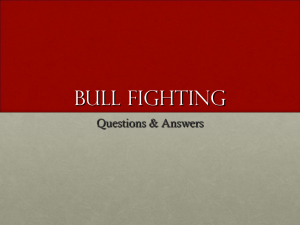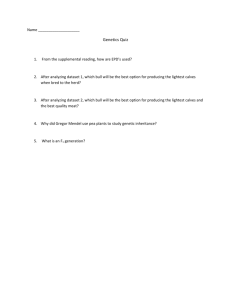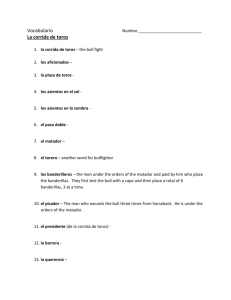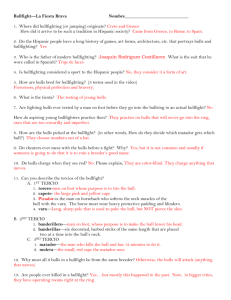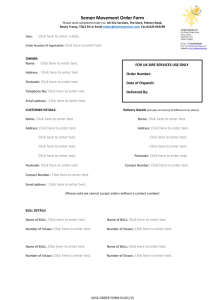Lacorridadetorosysuvocabulario
advertisement
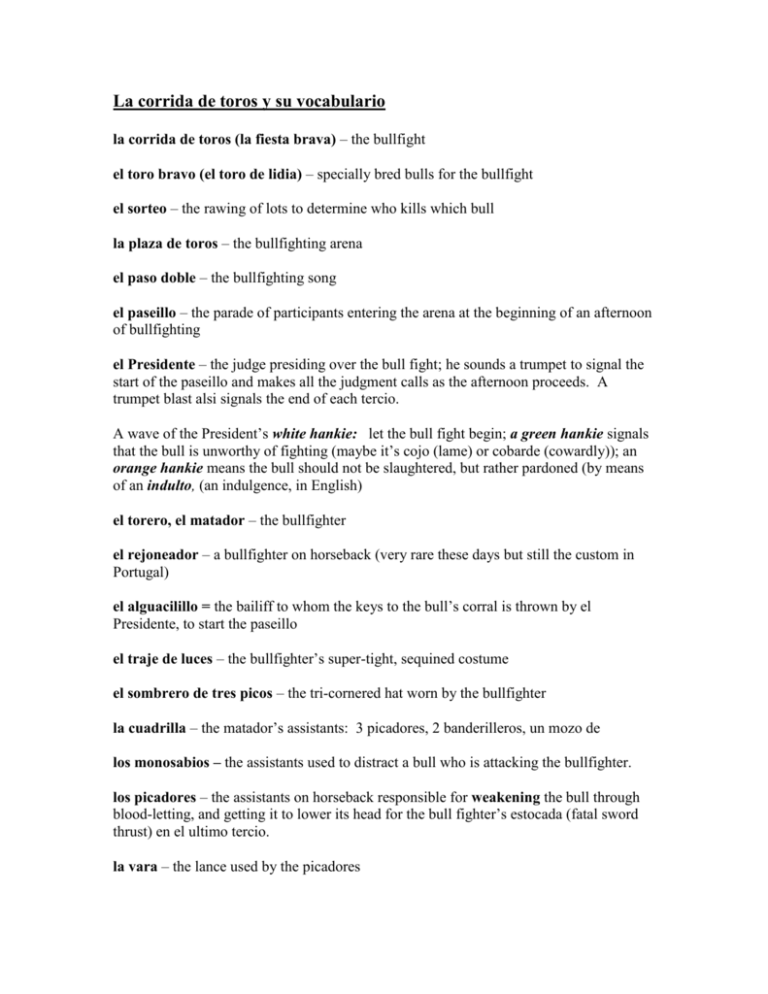
La corrida de toros y su vocabulario la corrida de toros (la fiesta brava) – the bullfight el toro bravo (el toro de lidia) – specially bred bulls for the bullfight el sorteo – the rawing of lots to determine who kills which bull la plaza de toros – the bullfighting arena el paso doble – the bullfighting song el paseillo – the parade of participants entering the arena at the beginning of an afternoon of bullfighting el Presidente – the judge presiding over the bull fight; he sounds a trumpet to signal the start of the paseillo and makes all the judgment calls as the afternoon proceeds. A trumpet blast alsi signals the end of each tercio. A wave of the President’s white hankie: let the bull fight begin; a green hankie signals that the bull is unworthy of fighting (maybe it’s cojo (lame) or cobarde (cowardly)); an orange hankie means the bull should not be slaughtered, but rather pardoned (by means of an indulto, (an indulgence, in English) el torero, el matador – the bullfighter el rejoneador – a bullfighter on horseback (very rare these days but still the custom in Portugal) el alguacilillo = the bailiff to whom the keys to the bull’s corral is thrown by el Presidente, to start the paseillo el traje de luces – the bullfighter’s super-tight, sequined costume el sombrero de tres picos – the tri-cornered hat worn by the bullfighter la cuadrilla – the matador’s assistants: 3 picadores, 2 banderilleros, un mozo de los monosabios – the assistants used to distract a bull who is attacking the bullfighter. los picadores – the assistants on horseback responsible for weakening the bull through blood-letting, and getting it to lower its head for the bull fighter’s estocada (fatal sword thrust) en el ultimo tercio. la vara – the lance used by the picadores el capote – the large yellow and pink cape used in the first tercio to study the bull’s movements and to tire the bull los banderilleros – bull fighters on foot who insert barbed, decorated, wooden sticks into the bull’s neck en el segundo tercio, to get the bull’s neck to lower for easier slaughter en el ultimo tercio. Their job is to correct any tendency to hook, to regulate the carriage of the head, and to slow the bull down. los tercios: the three phases or stages of the bull fight: el tercio de los picadores, el tercio de los banderilleros, y el tercio de la muerte/el tercio de la suerte. The bullfighter has six minutes to kill the bull and must salute el Presidente, by removing his hat, asking for permission to kill the bull before he begins. He may dedicate the bull to someone in the crowd, and sometimes will throw his hat over his head; if it lands upside down, it is bad luck. The bull fighter is supposed to wave his muleta (small red cape on a wooden stick) 40 times, luring the bull closer and closer to his body, the crowd crying ole with each pass. With each oass, the matador is supposed to lure the bull to come closer and closer to him. la estocada – the death blow to the bull, a sword between the cervical vertebrae into his heart, to sever the spinal cord for instantaneous death. If the bullfighter has performed well, he will be applauded do a lap of honor around the bullring, and be showered with cushions, flowers, cushions, hats or anything else at hand. If the crowd waves white handkerchiefs, they are requesting that the bullfighter be awarded trofeos: un oreja; dos orejas; o dos orejas y el rabo (los maximos trofeos). If the bull has put up a great fight, he will receive a lap of honor around the ring before his carcass is dragged out. On rare occasions, a bull will be pardoned in the third tercio: el Presidente will wave an orange hanky when the bullfighter request permission to kill the bull by removing his hat to salute the President. In this case, the bull is allowed to return to the stud farm to live out its life in peace. An afternoon of bullfighting involves 6 different bullfights, two per matador. The matadors perform in order of seniority, with the senior matador going first and fourth. If a matador is gored, the senior matador must return to the ring to complete the fight, which is now much more dangerous because the bull has learned to attack not the moving cape but the man. !Cojo! A cry to have the bull led out of the ring and slaughtered because it is lame and unworthy of fighting. Costillares killed 5,600 bulls and was never gored. Romero is considered the father of modern bullfighting. Manolete (el cordobes), who died in the ring, is considered by many to have been the greatest of all time. He has an entire museum of bullfighting dedicated to him. Bullfighting history goes back 20,000 years and the Roman gladiators even fought bulls. Bullfighting in one form or another can be found in Japan, India, Crete, and even now, in California (in a Portuguese area)! In Portugal, the bull is not killed in the ring and his horns are shaved and padded, which makes it safer for the bullfighter as far as goring is concerned, and the bullfighter is a rejoneador (on horseback). THE BULLFIGHT AND ITS CULTURAL SIGNIFICANCE Contrary to popular American opinion, bullfighting is not a blood sport; in fact, it is not even a sport and the bloodletting is not the point, it is incidental. It is, in a very real sense, the drama of live martyrdom: both bull and matador are charged with staring death down, unflinchingly. Their role is to show no fear, but to confront life’s challenges with unfailing bravery and, in the case of the bullfighter, with supreme art and absolute composure. The audience assembles with the expectation of seeing death and the understanding that blood will be shed but excessive use of la vara is not tolerated by the crowd, who want it simply serves to underscore the reality of the ultimate drama of the bullfight. In one sense, the bullfight is the highest form of tragedy because the deaths to be witnessed are real; in another sense, it is the lowest form of tragedy because the hero doesn’t always prevail. The bulls for the bullfight are specially bred for the greatest possible ferocity and aggression to make for the greatest possible spectacle. Only the finest are permitted their moment of glory in the bullring, before their slaughter. The others are led to the slaughter as a matter of course. (This is true of our own livestock, too: it is an expensive proposition to provide an animal weighing over a ton, land to graze on for a matter of years. It is done as a livelihood: the meat market is what makes the investment financially worthwhile.) The matador in the bullring is there as a Christian role model: we are compelled by our faith to do what is right without regard to the cost. All that is necessary for evil to triumph is an evil leader, if the rest of us are too cowardly to speak up. The bullfighter demonstrates that it is humanly possible not simply to put one’s life on the lineHistorically, The bullfighter is there as a reminder th



